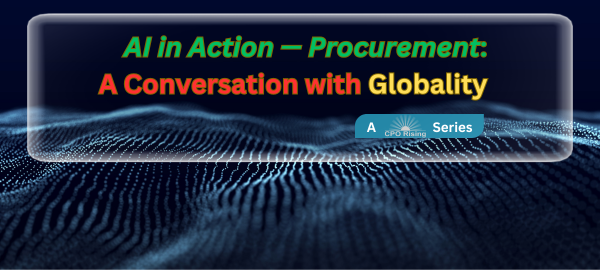A New AI Series on CPO Rising
The power of artificial intelligence (AI) is undeniable. Its impact and influence are revolutionizing the Procurement automation market. According to research from Ardent Partners, AI will soon be ubiquitous in this sector, offering unparalleled efficiencies and capabilities. The transformative possibilities of AI will drive innovations in source to pay, eSourcing, risk management, and overall supply chain management, streamlining enterprise operations and improving business decision-making.
In view of these advancements, Ardent Partners is excited to announce a special “AI in Action” interview series. We invite your company to participate in this series and contribute to the thought leadership around AI by having a product or strategy executive respond to high-level questions from Andrew Bartolini, our Founder and Chief Research Officer for Ardent Partners.
Today’s AI in Action profile features a conversation with Globality’s Keith Hausmann, Chief Customer Officer, and Keith McFarlane, Chief Technology Officer.
AB: Good day Keith and Keith, tell our readers a little bit about yourselves.
KH: My name is Keith Hausmann, and I am a well-known procurement thought leader in the sourcing and procurement domain. I was previously Accenture’s Global Head of Procurement and Supply Chain Operations where my team of more than 15,000 people managed over $300 billion in spend. Prior to this I co-founded Procurian and regularly facilitated roundtable discussions for industry groups such as Digital Procurement World (DPW), Art of Procurement, and the Sourcing Industry Group (SIG).
KM: My name is Keith McFarlane, and I am a software applications veteran with over 25 years of experience. I have a passion for building applications and organizations that perform and scale. From my early days with AT&T Bell Laboratories to my years building out the Oracle Service Cloud, I have run and grown diverse, open, and collaborative teams and organizations that continuously innovate while producing applications of the highest quality.

AB: Thank you. I think I know your answer but let me ask anyway … what are the biggest opportunities for AI to improve procurement efficiencies and productivity?
KH: There’s no doubt that the biggest opportunity is in sourcing and contracting. The biggest processes that take a lot of labor and are relatively high in repeatable volume are sourcing, contracting, and procure-to-pay. And procure-to-pay is a process that’s been automated for years using systems and RPA and different things.
So, there really has never been any intelligent automation applied to sourcing and little automation applied to contracting. However, those processes are particularly value creating —driven by insight, data, and analysis — and should be highlighted as strong opportunities.

The CFO and CPO of financial services leader T-Rowe Price, a customer of ours, identified sourcing as an area where procurement could lead the business in adoption of AI. This poses an obvious opportunity seeing that most of what sourcing and contracting does is related to language and data, which is exactly what Large Language Models (LLMs) and GenAI are all about.
AB: How are you ensuring the accuracy and reliability of customers’ AI models (AI data output)?
KM: Data quality is the central factor in determining the effectiveness of an AI model. Over our near 10-year history, Globality has collected an immense amount of data applicable to autonomous sourcing (project titles and descriptions, service provider case studies and ratings, etc.). With the consent of our customers, we curate, anonymize, and apply this data to building our in-house models, which we use for tasks ranging from classifying a project’s potential service requirements from its natural language description to finding providers with similar chances for success. Over the years, we have vastly improved our understanding and application of this data, and we have increased the rate of data ingestion.
We’ve also built a regime of verification around our AI models that prevents regression in prediction quality. We pay close attention to standard model performance metrics (accuracy, precision, recall, F1 scores, etc.), and track these metrics over time. We also prevent release of models that show dips in predictive power against our internal benchmarks. Further, as we are an AI Native company, our AI verification extends to in-context product testing, where we verify, independent of model metrics, that the product behaves as it should when an improved model is engaged. Our product has been grounded in solid AI fundamentals from its conception, and we apply a systematic and scientific approach towards the improvement of a model’s prediction quality.
We also use third-party large language models (LLMs) in our product. Although we do not train/fine-tune these models, we apply the same scientific principles and validation tools to our prompt engineering efforts, ensuring that each instruction in any given prompt is optimized to render an accurate result.
AB: What are the leading AI subsets (e.g., machine learning, natural language processing, deep learning, etc.) with the biggest impact on procurement solutions? And why?
KM: Throughout the lifetime of our company, we at Globality have experimented with many different AI techniques, some of which have become part of the product and some of which have been set aside. We have found that many of the classical, numerical machine learning models hold tremendous power when applied to certain problems in procurement and have similarly found certain families of neural networks to be best suited to our tasks involving long-form language.
Deep learning models (particularly transformers) in all their forms have been the biggest game changers in our space by far. It is well known that procurement is a discipline ruled by the written word, and that sufficiently descriptive project materials lead to better assessments of provider fit. We knew this in 2016 when our first NLP-driven features (e.g., simple keyword identification) began to take shape, and we pursued prediction of various project characteristics (which category is this for? what industry? what services will be required?) through experiments with multiple neural network architectures. Once transformers arrived on the scene, our classifiers gained both accuracy and capacity, and we’ve since brought ongoing improvements in this key technology into the product.
Of course, most public discussions of deep learning neural networks revolve around generative AI, which itself has had a profound impact on both our industry at large and on our product in particular. This is a natural extension of the transformer’s success in the procurement universe; any technology with the ability to extract complex intent from a mass of project documents portends revolutionary change in procurement technologies and processes.
AB: How can you support procurement clients when an AI skills gap deficiency exists?
KH: If procurement is using the best-of-breed AI-driven platforms and solutions out there, then you don’t need to have “AI skills.” The ProcureTech landscape is filled with AI skills and procurement expertise, and for a typical company, the problem to solve is about applying these technologies, not being an expert in the underlying way it works or trying to build it internally. Of course, companies must have the right governance around AI but this isn’t a requirement of the procurement function per se. Ultimately, it is about a willingness to think differently about how the work gets done.
Because a native-built AI platform, such as Globality, has all the AI skills that procurement needs. Procurement teams don’t need to be specialists or experts in AI to use them in any shape or form.
What it boils down to is the willingness among procurement teams to embrace and adopt AI-powered applications that make them more effective and efficient. Where a skills gap exists in procurement — and it’s not around AI — is other skills referred to as truly human attributes around strategic thinking, emotional intelligence, relationship development, and bringing organizations along on a new and better journey.
And by automating low-value, repetitive, manual tasks and processes, AI will give procurement professionals the time to be a business relationship manager, either with the supplier or the business stakeholder, or both. And upskilling will help procurement professionals become experts in problem solving and change management as opposed to anything related to being an expert in AI.
AB: How do you view your customers’ (and prospective customers’) AI attitudes?
KH: The nature of Globality as an AI-driven platform means that our customers will always be leaders and innovators. Ditto, if they’re truly a prospective customer of ours, they’re probably in the similar mindset.
I think there’s a slowly decreasing minority of procurement leaders who are suspicious about AI, and who perhaps thought that it wasn’t real, or it was replacing jobs or was going to steal their data.
As Klaus Staubizter, Siemens CPO, said at DPW Amsterdam in October: “Digital leadership is pretty simple — make sure that AI is seen as a colleague and not a supervisor.”
As the market becomes more educated on seeing AI in this way — as an extension of their people — AI in effect becomes the newest procurement team member, which is how Tesco CPO Charles Letizia describes our AI Agent Glo, then there’s less to be afraid of.
Procurement has often been seen as a transactional function rather than a strategic one that helps build value or create growth. But now it has a unique opportunity to become a beacon across the enterprise. All business functions across companies are being charged with finding tangible use cases for AI and autonomous sourcing — something the CEO at T. Rowe Price highlighted in an interview with the Financial Times’ Ignites publication.
AB: I appreciate your time today!
KH and KM: Thank you.

